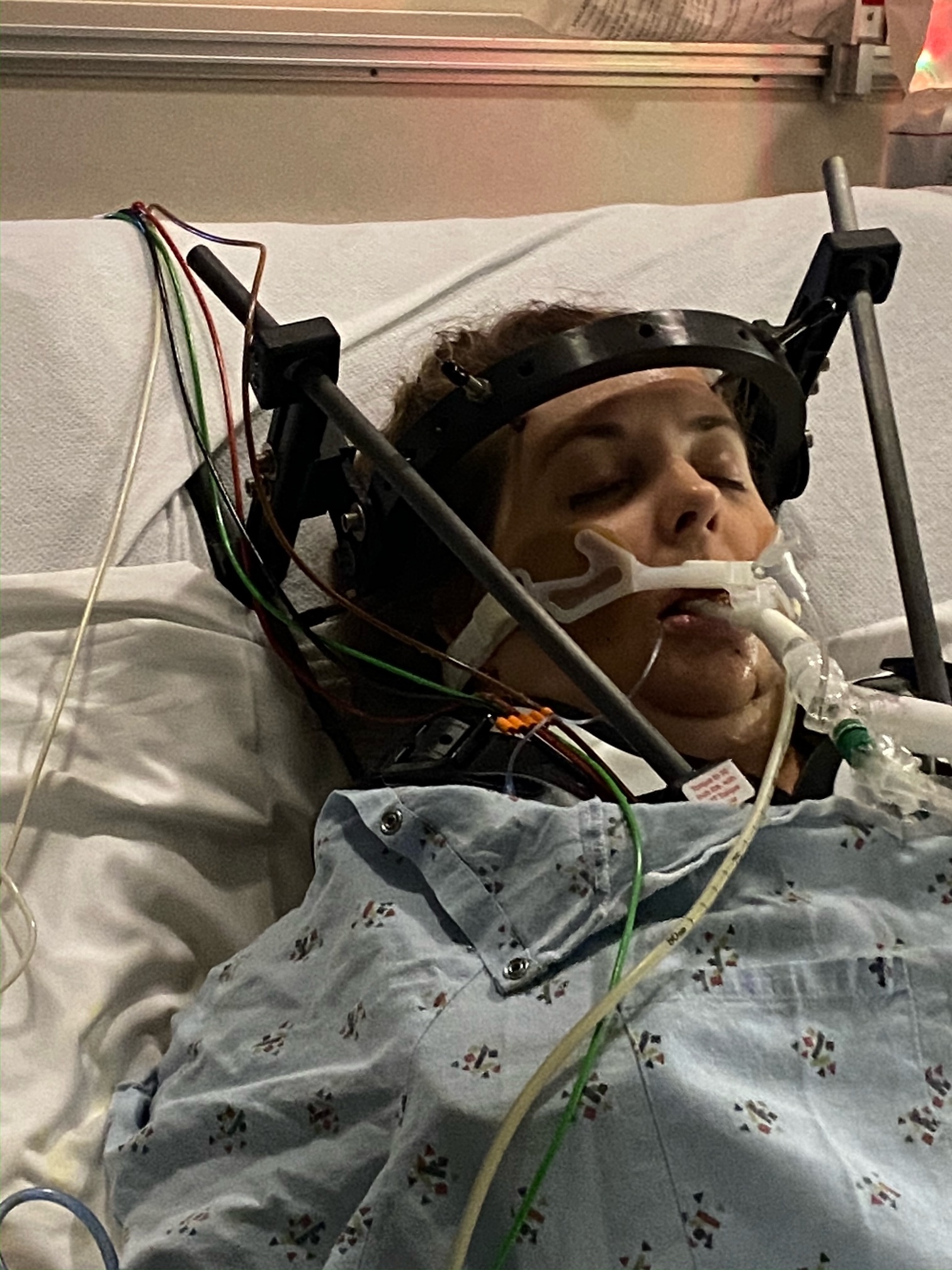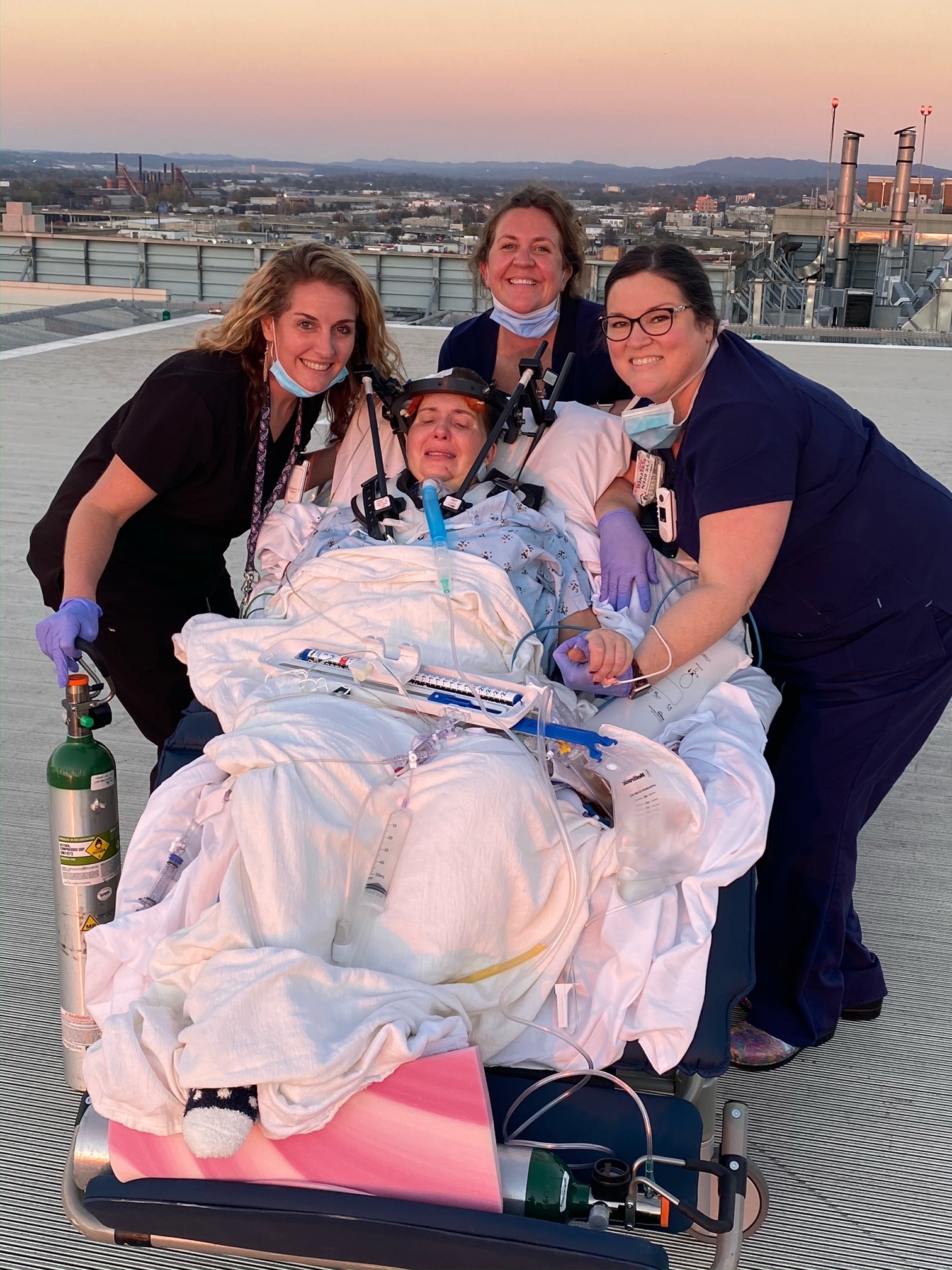Written by: Emma Shepard
Media contact: Bob Shepard

Christy Bullock was taking a motorcycle ride with her father in fall 2021 near Mount Cheaha in east Alabama. It was a ride that would change her life forever.
A tricky turn around a curve did not go as planned, and she hit a guardrail. The guardrail stopped her body but — with the weight of her helmet — her head kept moving forward. After that, the scene faded around her.
The paramedics who responded to the call were not just any paramedics — they were Bullock’s co-workers. Bullock had been a paramedic for 11 years, and her co-workers and friends were first on the scene to treat her. Her husband was also a paramedic and was originally scheduled to work that day but, thankfully, did not.
Bullock was airlifted to the University of Alabama at Birmingham. Her prognosis was poor. She had a tear in her vertebral and carotid arteries, as well as a significant laceration on her chin. She sustained a major, paralyzing injury to her arm and an injury to her brachial plexus, which is a network of nerves that send signals from the spinal cord to the shoulder, arm and hand.
Bullock also had a tibial plateau fracture, five or six ribs were fractured, and she had a liver laceration, adrenal hematomas and a laceration of her spleen. If that were not enough, her lungs were bruised, and many internal organs were bruised or bleeding.
But that wasn’t the worst of it. She also had an atlanto-occipital dislocation. An internal decapitation.
Trauma surgeon Lauren Tanner, M.D., in the Division of Trauma and Acute Care Surgery, admitted Bullock on her arrival at UAB Hospital. In addition to the immediate trauma care team, Bullock was also treated by Department of NeurosurgeryAssistant Professor Jakub Godzik, M.D., who described the situation as grim at best.
“The most life-threatening of her injuries was an atlanto-occipital dislocation — which means all ligaments that connect her skull to her spine were severed. This is often fatal,” Godzik said. “Just to put it in perspective, the normal distance between the skull and spine is usually 1-2 millimeters. Survivable trauma might reach 3-5mm of separation. Hers was 10-15mm.”
Coming to
Bullock’s first memory in the hospital was seeing respiratory therapist Lori Ann Patterson, who called her daughter, Natalie, a friend of Bullock’s, on FaceTime. Bullock says this was several days after the injury.
“I just remember seeing a familiar face and sobbing because that was the first time I felt like a human being again,” Bullock said. “I was intubated on the ventilator, and my arm was paralyzed. Plus, I was stabilized by the halo neck stabilizer, so couldn’t communicate.”

A halo device protects the spine and neck following a serious accident or injury. While it serves an essential function of preventing further damage to the injured areas, it can feel extremely restrictive for patients. That and the endless days in intensive care eventually began to take their toll on Bullock.
“I was in the UAB ICU for almost three months,” Bullock said. “I had a really hard time. Days and nights starting mixing, and I was experiencing deliria.”
Operation Sunset
Bullock’s nurses — Stacey McCoy and Lauren Brown — who she still talks with to this day, noticed she was having a hard time. So, they enacted “Operation Sunset.” After about an hour of safely preparing Bullock for the transport, Bullock’s nurses wheeled her up to the helipad of UAB Hospital so that Bullock could see the sunset. For Bullock, this was a memory she will never forget.
“When they took me up to see the sunset over Birmingham, I cried the entire time, and so did my family,” Bullock said. “UAB went above and beyond caring for me. Stacey and Lauren also came to see me often, doing my hair, painting my nails and decorating my room in Christmas lights, even on their days off.”
Bullock notes that Godzik also checked on her daily, returning to see how she was doing and even coming up to the hospital on Thanksgiving Day to visit her and to make her holiday in the ICU a little bit more bearable.
“The extent of the separation is mainly the reason Mrs. Bullock’s survival was astounding,” said Godzik. “The degree of damage to the craniocervical junction resulted in an unusual post-operative course and complications, such as delayed hydrocephalus that resulted in a temporary comatose state. The extent of her injury was truly unique, and it was amazing to see her recover so well. I would come close to saying her survival was a near miracle.”
The beauty of multidisciplinary care
Godzik notes that part of Bullock’s successful recovery was thanks to the collaborative nature of the UAB Department of Neurosurgery and all teams involved in her care.
“It would not have been possible to get her to where she is now without the teamwork of the neuro-critical care team, trauma team and neurosurgical team. Her unique case was reviewed many times at our spine indications conference,” Godzik said. “With this collective experience, we were able to navigate her complex post-operative course.”
Bullock is now mobile and walking. She does physical therapy twice a week, specifically for her right leg, which she hopes will make a full recovery. Last month, Bullock had another follow-up surgery for her Achilles tendon with Department of Orthopaedic Surgery Assistant Professor Michael Johnson, M.D., on her road to healing.
Most recently, Section Chief of Trauma Jonathan Quade, M.D., removed the hardware installed by Johnson, and Bullock also has a knee surgery scheduled with Section Chief of Sports Medicine Amit Momaya, M.D.
Bad days. But good days, too
“I would like to tell people that your recovery and emotions will ebb and flow. There will be very difficult times mentally and physically. It’s important to remember on the bad days that a good day is on the horizon, and for me, those dark days have made the good days that much better,” Bullock said.
Trauma survivors and their families are invited to join the Trauma Survivors Network at UAB. The TSN provides a community for those looking to connect with others and rebuild their lives after traumatic injury. The TSN offers resources, peer support and opportunities to give back to others.
Skip past news feed


